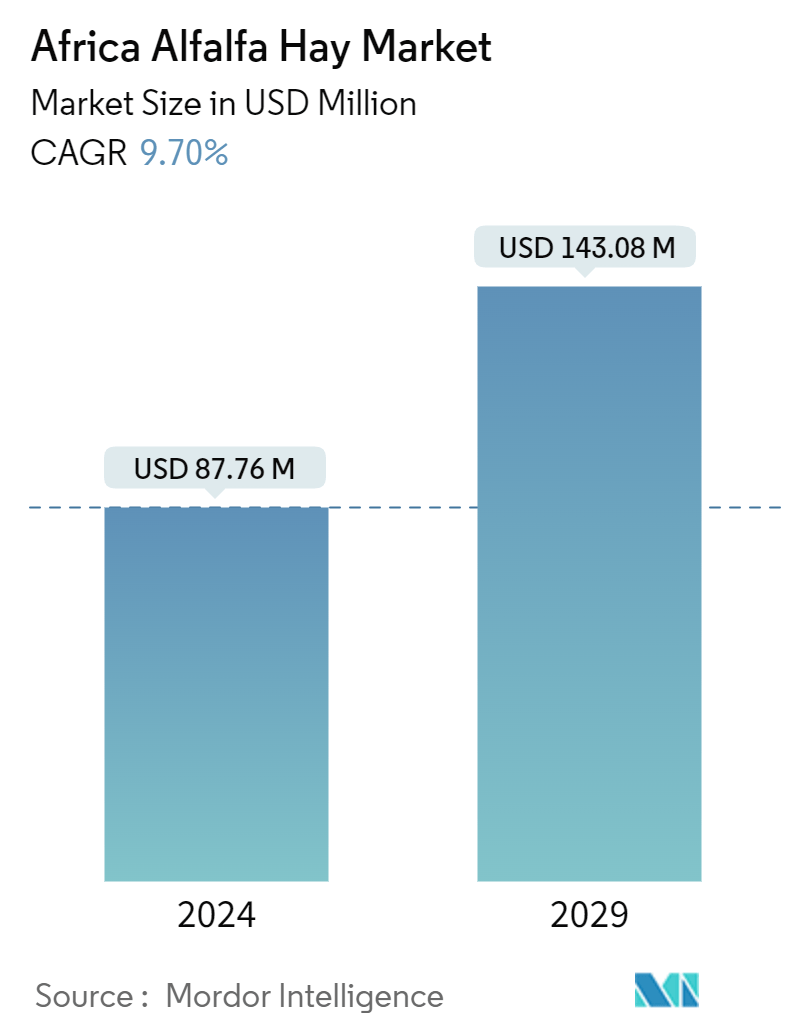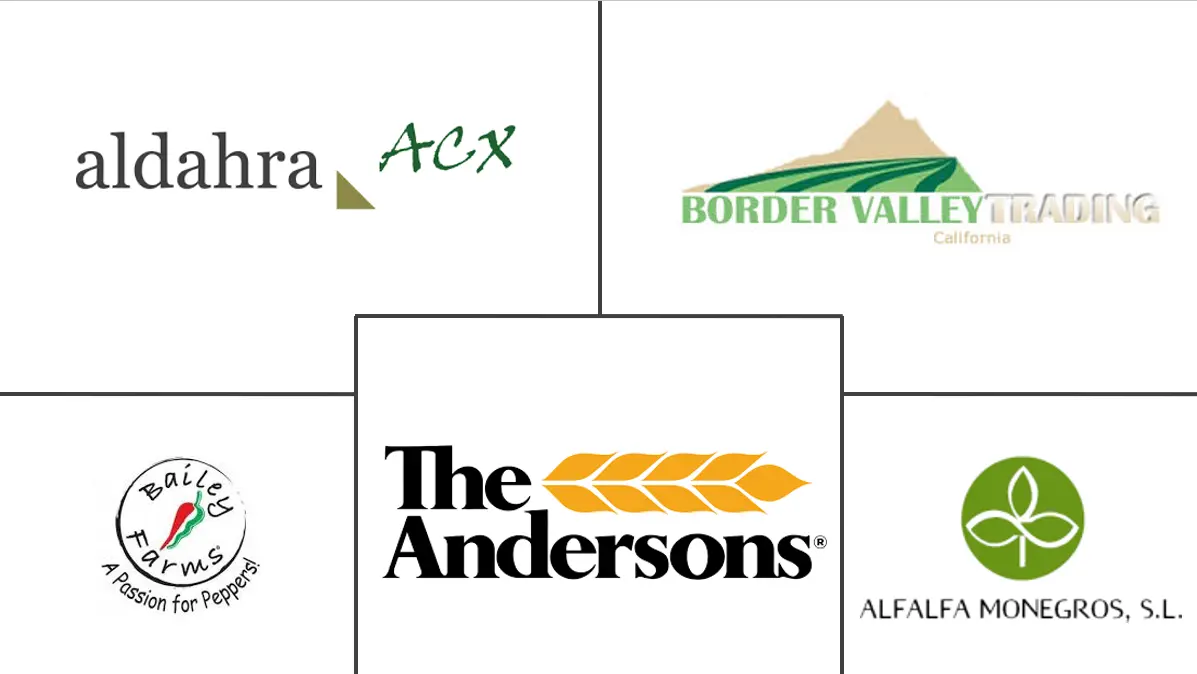Market Size of Africa Alfalfa Hay Industry

| Study Period | 2019 - 2029 |
| Base Year For Estimation | 2023 |
| Market Size (2024) | USD 87.76 Million |
| Market Size (2029) | USD 143.08 Million |
| CAGR (2024 - 2029) | 9.70 % |
| Market Concentration | Low |
Major Players
*Disclaimer: Major Players sorted in no particular order |
Africa Alfalfa Hay Market Analysis
The Africa Alfalfa Hay Market size is estimated at USD 87.76 million in 2024, and is expected to reach USD 143.08 million by 2029, growing at a CAGR of 9.70% during the forecast period (2024-2029).
- Africa's livestock sector is witnessing growth, especially in terms of dairy and beef production, fueled by a burgeoning population and increasing incomes. Alfalfa hay, a vital and nutritious feed for these animals, is propelling this demand. To meet its livestock feed needs, the continent relies on domestic production as well as imports. Data from the ITC Trade Map revealed that in 2023, the region's alfalfa hay imports reached 70,274 metric tons, marking a 22.4% increase from the preceding year. The beef industry, predominantly managed by small-scale farmers, plays a crucial role in the region's food security. The farmers traditionally feed their cattle alfalfa hay. As highlighted by SME Blue Pages, Africa boasts a significant beef production capacity, housing 300 million cattle, with South Africa leading the charge, producing a notable 1.2 million metric tons of beef.
- Sudan, leveraging its strategic geographical location, favorable climate, and Nile-sourced water resources, stands as Africa's top producer of alfalfa hay, with South Africa trailing closely. This positioning has cemented Sudan's role as a pivotal player in the Middle Eastern alfalfa market. Several firms involved in alfalfa production have diversified, venturing into local dairy farming. Their goal is to export value-added products, such as live calves and meat, targeting markets in the United Arab Emirates, Qatar, and Saudi Arabia. However, with declining prices for alfalfa hay in Sudan, domestic consumption is expected to wane in the coming years. South Africa has recently taken the lead in the market, driven by heightened demand amid Africa's severe drought. Known for its superior quality and grading, South African alfalfa (lucerne) has found a global export market. The market is poised for growth, fueled by a rising cattle population and an escalating demand for premium feed.
Africa Alfalfa Hay Industry Segmentation
Alfalfa hay is obtained from the alfalfa plant, also known as lucerne and medicago sativa. It is cultivated as an important forage crop in many countries worldwide.
The African alfalfa hay market is segmented by product type (bales, pellets, and cubes), application (meat/dairy animal feed, poultry feed, horse feed, and other applications), and geography (South Africa, Sudan, Uganda, Tanzania, Kenya, and Rest of Africa). The market sizing is provided in value terms (USD) for all the above-mentioned segments.
| Product Type | |
| Bales | |
| Pellets | |
| Cubes |
| Application | |
| Meat/Dairy Animal Feed | |
| Poultry Feed | |
| Horse Feed | |
| Other Applications |
| Geography | ||||||||
|
Africa Alfalfa Hay Market Size Summary
The African alfalfa hay market is experiencing significant growth, driven by its essential role as a high-protein and digestible fiber forage for livestock. This demand is fueled by the increasing need for dairy and animal products, the reduction of grazing land, and the rise in high-yielding cattle. Sudan and South Africa are key players in this market, with Sudan benefiting from its favorable geographical and climatic conditions, while South Africa's high-quality alfalfa exports are in demand globally. The market's expansion is supported by the growing cattle population and the rising demand for quality feed, which are crucial for enhancing livestock productivity and meeting the nutritional needs of the region's rural population.
The market landscape is characterized by a fragmented structure with a few dominant players, such as Al Dahra ACX Global Inc., Alfalfa Monegros SL, and others, who are actively engaging in strategic partnerships and expansions to strengthen their market presence. The export opportunities are further bolstered by the increasing demand from countries like the United Arab Emirates and China, which are experiencing shortages in local alfalfa supply. Additionally, foreign investments, particularly from Gulf Cooperation Council countries, are expected to enhance production capabilities in Sudan, further increasing export potential. The ongoing projects and feasibility studies aim to capitalize on the region's favorable conditions for alfalfa production, ensuring sustained growth in the market.
Africa Alfalfa Hay Market Size - Table of Contents
-
1. MARKET DYNAMICS
-
1.1 Market Overview
-
1.2 Market Drivers
-
1.2.1 Rising Demand for Quality Feed in Meat & Dairy Cattle
-
1.2.2 Increasing Alfalfa Hay Exports from Africa
-
1.2.3 Government Initiatives are Propelling the Market
-
-
1.3 Market Restraints
-
1.3.1 Competition From Other Forages
-
1.3.2 Drought Conditions Limiting Production
-
-
1.4 Porter's Five Forces Analysis
-
1.4.1 Threat of New Entrants
-
1.4.2 Bargaining Power of Buyers/Consumers
-
1.4.3 Bargaining Power of Suppliers
-
1.4.4 Threat of Substitute Products
-
1.4.5 Intensity of Competitive Rivalry
-
-
-
2. MARKET SEGMENTATION
-
2.1 Product Type
-
2.1.1 Bales
-
2.1.2 Pellets
-
2.1.3 Cubes
-
-
2.2 Application
-
2.2.1 Meat/Dairy Animal Feed
-
2.2.2 Poultry Feed
-
2.2.3 Horse Feed
-
2.2.4 Other Applications
-
-
2.3 Geography
-
2.3.1 Africa
-
2.3.1.1 South Africa
-
2.3.1.2 Sudan
-
2.3.1.3 Uganda
-
2.3.1.4 Tanzania
-
2.3.1.5 Kenya
-
2.3.1.6 Rest of Africa
-
-
-
Africa Alfalfa Hay Market Size FAQs
How big is the Africa Alfalfa Hay Market?
The Africa Alfalfa Hay Market size is expected to reach USD 87.76 million in 2024 and grow at a CAGR of 9.70% to reach USD 143.08 million by 2029.
What is the current Africa Alfalfa Hay Market size?
In 2024, the Africa Alfalfa Hay Market size is expected to reach USD 87.76 million.

